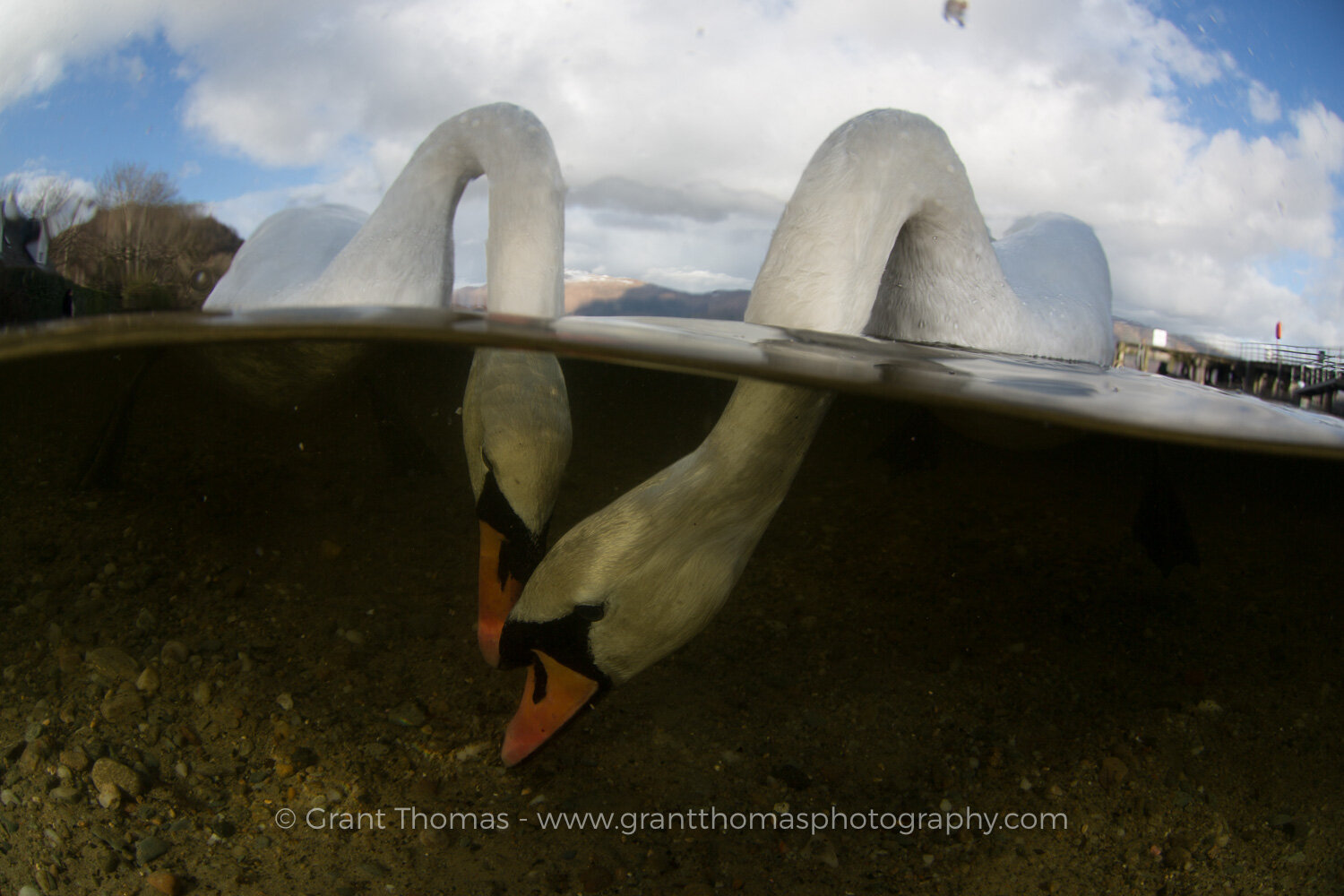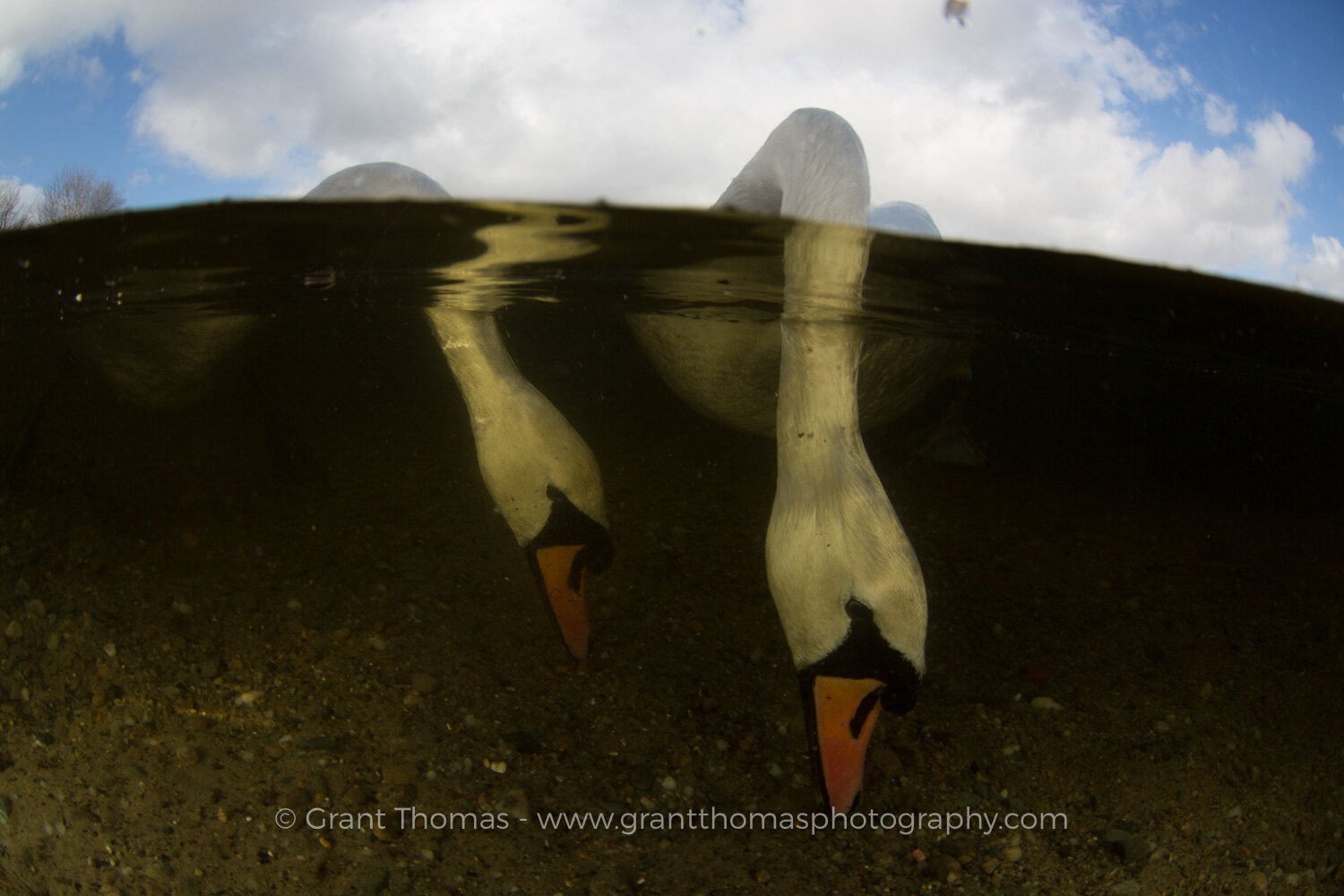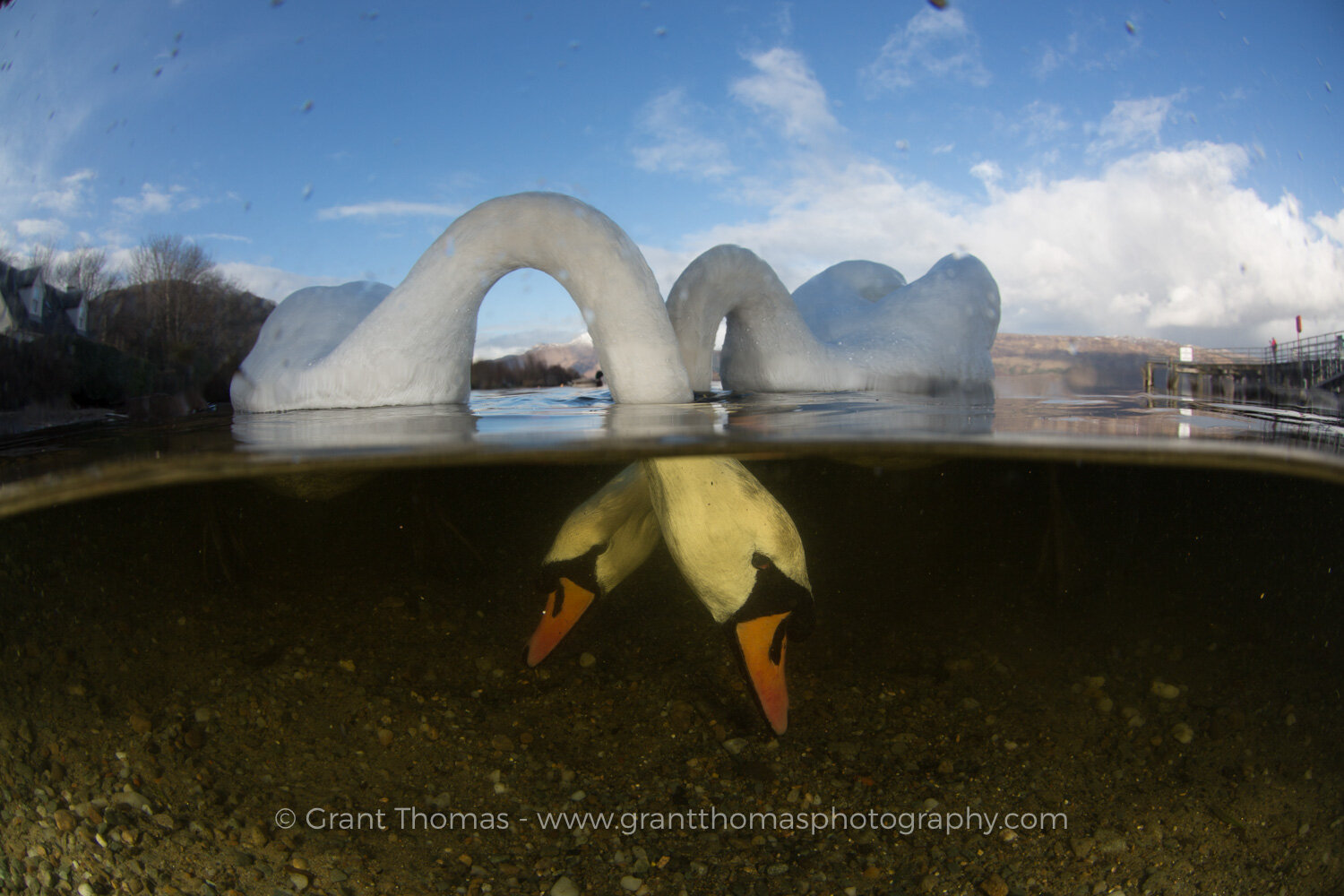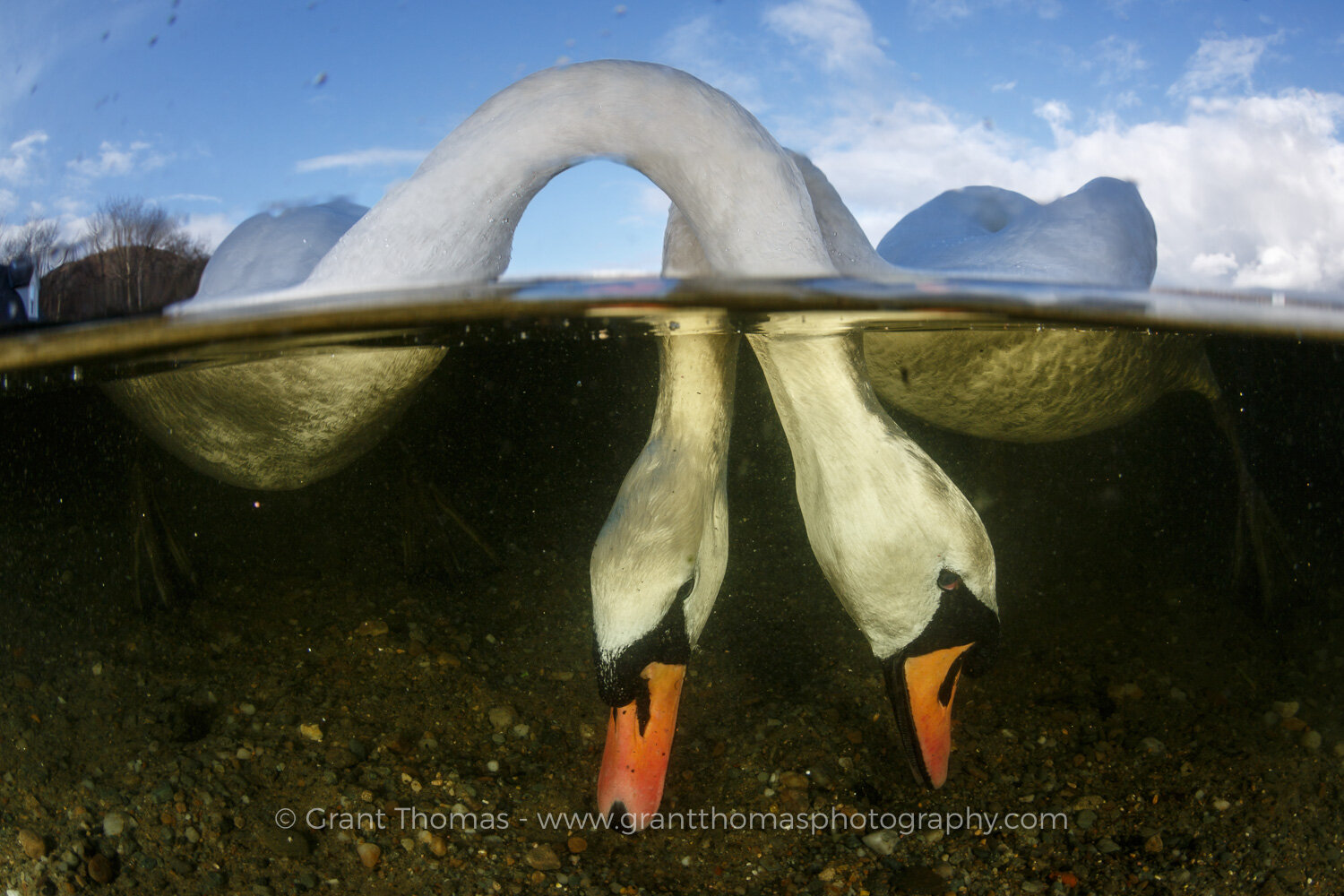How Did You Do That? Chat | Love Birds
‘Love Birds’ by Grant Thomas
Shooter | Grant Thomas
A founding member of The Shot Chat, Grant’s split level imagery may be swooping up endless awards, as well as the adoration of the general public, but here we all know it really means he is only half an underwater photographer.
True story: Grant is frequently confused with a fashion photographer of the same name, nationality and birth year. He frequently receives emails requesting fashion shoots, but has so far resisted the urge to switch fish for supermodels.
Find him at www.grantthomasphotography.com and on Instagram
Part 1 | Conception
Is this image and composition something you planned in advance?
Grant Thomas: I remember the first time I saw an under-over image, it was a seascape by Sean Scott, and I just couldn’t take my eyes off of it. I just love the impact of a well crafted under-over image, as (when done well) it can create a strong visual connection between the terrestrial world we all know and the more mysterious underwater world, which I think in this day and age is a powerful tool for inspiring people who may not have ever stepped foot in an ocean. This type of imagery from photographers such as David Doubilet, Matty Smith and Alex Mustard is what inspired me to become a photographer.
“my swan image is actually one that I spent months thinking about and planning”
The majority of the time I like to think of myself as more of a spontaneous shooter, as I find it easier to develop ideas in the present moment, however, my swan image is actually one that I spent months thinking about and planning. In 2016, I was working as a dive instructor in Malaysia and had just purchased my first underwater camera setup. I spent just about everyday in the water shooting and immediately developed an obsession with split shots. I remember reading Alex Mustard’s Underwater Photography Masterclass book multiple times that year and being absolutely fixated on the section about split shots.
This shot of feeding pelicans by Simone Caprodossi was part of Grant’s inspiration for his eventual swan image. Simone owns Sun Dive in Byron Bay and has a rather stunning, global portfolio of shots. Follow him here.
Then one day I saw an under-over image of pelicans by Simone Caprodossi and was completely blown away. My first thought was to try and replicate the image but with what? There are no pelicans in Malaysia… Then I remembered, I was planning to visit my family in the UK at the end of the year and we have swans, they’re kind of like pelicans right? So, I began thinking of places where I could access the water easily, with calm conditions, good visibility, pleasant background scenery etc… and swans of course. Even after I arrived home, it took me another 3 months to finally find a location which worked (Scottish weather can be pretty miserable in winter). Eventually I settled on a small place called Luss which is located on the shores of Loch Lomond, not far from my home in Glasgow. With easy shore access and idyllic scenery, as well as being a popular hangout for local swans, it seemed an ideal place to start.
Part 2 | Getting the Shot
A behind the scenes shot during one of our scouting missions to find a good location for shooting. You can see how friendly the swans were.
Equipment: Canon 5dmkiii, Tokina 10-17mm fish eye @15mm, 2 x Inon z240 strobes, 8.5" ikelite dome port.
Location: Luss Pier, Loch Lomond, Scotland.
Time: The image was taken at midday with the sun at my back.
Water conditions: Water visibility was around half a metre and water temperature around 8 Celsius. Flat calm conditions.
Other gear: rubber boots, a jacket and a woolly hat. I tried using a mask but it was pretty useless due to the shallow depth of the water therefore I chose to ‘shoot from the hip’
Help: I did have my wonderful “assistant” Aneesh on hand to help with everything from setting up gear to helping me stand up after my legs had frozen into place.
Settings: f/14, 1/80s, ISO 125.
At the time I had been shooting underwater for less than a year so I was relatively inexperienced and it’s hard to say what were my exact thought processes were for settings, but looking at them now I would have chosen differently. I would have bumped my ISO up a lot higher, making use of the Canon’s amazing low light capability, in order to narrow my aperture and bring more of the image into focus i.e the water line and background etc…
Strobes were set at mid to high power and would have been positioned at 4 and 8 o’clock around the dome port, pulled back behind my handles on the housing and pointing slightly up to avoid over exposing the sand.
The reason i would normally shoot 14/15mm on the Tok is because it was designed for crop sensor and i was using a full frame 5dmkiii. This means that any wider than about 14.5mm and you start to get vignetting/seeing the inner corners of the lens
The Story
Swans are large birds and can be very territorial so I was nervous getting into the water at first, but the slow and steady approach served me well. The water is less than half a metre deep so I wasn’t fully submerged, only my legs. I waded out from the shore, squatted down and waited, trying to be as still as possible… and waited… and waited. After sometime, the swans did eventually begin to approach me and then before I knew it I had two of them tangling their long necks around my strobe arms and that’s when I knew I wanted to try capture a shot with their necks crossing. I spent over 4 hours sitting in the water waiting for that perfect moment and then just as I thought my fingers and toes were about to freeze off it happened! It was a valuable lesson on the importance of patience when it comes to nature photography.
“After sometime, the swans did eventually begin to approach me and then before I knew it I had two of them tangling their long necks around my strobe arms and that’s when I knew I wanted to try capture a shot with their necks crossing.”
Biggest challenge?
Finding a location which ticked all the boxes i.e easy access to the water, calm conditions, good visibility, pleasant background scenery etc… and swans of course.
Can you share some other frames from this shoot? Either moments of breakthrough which led to the image we see now, or other strong frames which you considered before settling on this one as the best?
The following images were all shot on the same day and are in chronological order. I tried shooting at multiple angles with the camera pointing upwards or downwards and eventually settled with a slightly downward angle, as I liked the way it captured more of the upper scene. I also tried landscape and portrait orientation but when I realized I could possibly capture the swans as they crossed their necks I settled on landscape.






Part 3 | After the Shot
Did you know you had something special in the moment?
I knew I had something relatively unique but I never thought it would change my life in the way it did.
Post-processing: can you describe the programmes you used, and what you did please?
I use Lightroom to edit most of my images and only switch to Photoshop if I really need to do something more extensive. In this case I only used Lightroom and there wasn’t much editing involved. Basic exposure adjustments, clarity and sharpness, white balance/colour correction and spot removal of a couple of water droplets on the upper half of the image.
Do you think you could repeat the shot?
I actually tried to repeat this shot last year and never quite managed. There are a lot of different variables which had to come together in order to make it work on the day i.e weather, water conditions, lighting, cooperative swans and a lot of luck with regards to their positioning etc… Turns out it was a lot harder than I remember but that’s nature!
What has been the 'career' of this shot: talk us through its reception, competition wins, commercial performance...
When I shot this image I was still working as a dive instructor and only dreamt of making a career from photography. Therefore most of my images just went up on social media and the occasional blog/forum pages etc… Then at the end of 2017, I decided to enter it into several photography competitions. To my surprise, it went on to win the British Wide category of the Underwater Photographer of the Year and had me named British Underwater Photographer of the year. I still remember reading the congratulatory email from UPY and thinking they must have sent it to the wrong person!
The media coverage from UPY as well as the confidence boost I got from creating a prize-winning image is what helped me go on to build a career in photography and I’m truly grateful for that.
As this image was taken before I began carving a career in photography I hadn’t had much experience in selling or publishing images, therefore in all honesty, I didn’t really know what to do with it at the time. The media coverage from UPY was a blessing, as I actually had companies approaching me for use of the image, which gave me a great jump-start in learning how to price and negotiate image rights and terms of use etc… I believe the picture best serves as a stock image or possibly as part of a series of images for a wildlife article or photographing bird/wildlife up close. But I’m always open to other ideas…
Is there any aspect of the shot which you think could be improved? If you were trying again today, is there anything you'd do differently?
I look at every image I take and no matter how good it is I always think it can be better, otherwise how would I ever improve. In the case of the swans I would like to try shoot the same image later or earlier in the day. during “golden hour”, to create softer and warmer ambient light. And as I said earlier I would have bumped my ISO up a lot higher, making use of the Canon’s amazing low light capability, in order to narrow my aperture and bring more of the image into focus i.e the water line and background etc…
